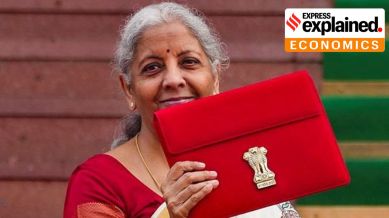What did the Budget say about ‘Make in India’?
Budget 2025 Highlights: Finance Minister Nirmala Sitharaman said that furthering Make in India is one of the government’s 10 broad focus areas for the coming year

Finance Minister Nirmala Sitharaman while presenting the Union Budget on Saturday (February 1) said that the ‘Make in India’ is one of the 10 broad areas of focus for the government in the coming year.
“In this Budget, the proposed development measures span ten broad areas focusing on Garib [the poor], Youth, Annadata [farmers], and Nari [women]… 6) Boosting manufacturing and furthering Make in India…,” the Finance Minister said.
monthly limit of free stories.
with an Express account.
Here are some specific announcements from the Budget speech pertaining to ‘Make in India’, and the government’s efforts to boost domestic manufacturing in the country.
What is Make in India?
‘Make in India’ was launched in 2014 with the singular aim of boosting domestic production. The mission aims to “facilitate investment, foster innovation, enhance skill development, protect intellectual property, and build best-in-class manufacturing infrastructure”, according to its website.
These aims will be achieved by “entering new processes, building new infrastructure, entering new manufacturing sectors, and providing a new ‘mindset’ of public-private partnership”.
According to the Economic Survey 2025 released on Friday (January 31), the industrial sector is estimated to grow by 6.2% in FY 2025.
Launch of the National Manufacturing Mission
The Budget notably announced the launch of the National Manufacturing Mission which will cover small, medium and large industries. The Mission will provide policy support, execution roadmaps, governance and monitoring framework for central ministries and states.
The mission has identified the following areas of focus:
-
Enhancing ease and cost of doing business;
-
Building a future-ready workforce for in-demand jobs;
-
A vibrant and dynamic MSME sector;
-
Ensuring availability of technology; and
-
Manufacturing quality products.
Story continues below this ad
Policy measures to boost domestic manufacturing
Here is a thematic breakdown of some specific policy measures to boost domestic manufacturing and value addition announced in the Budget.
- 01
Critical minerals
-
Previous budget: BCD (Basic Customs Duty) exemption on 25 critical minerals not domestically available and a reduction in BCD of 2 other minerals to boost their processing, especially by MSMEs.
-
Now: No BCD on cobalt powder and waste, the scrap of the lithium-ion battery, Lead, Zinc and 12 more critical minerals.
-
- 02
Textiles
-
Goals: Support Make in India, rectify inverted duty structure
-
Increasing BCD on Interactive Flat Panel Display (IFPD) from 10% to 20%
-
Reducing BCD on open cells and other components of IFPD to 5%
-
Exempting BCD on open cells and parts of LCD/LED TVs to boost their manufacture
-
- 03
Lithium ion battery
-
Goal: To boost domestic manufacture of lithium-ion batteries for mobile phones and electric vehicles.
-
35 additional capital goods for EV battery manufacturing, 28 additional capital goods for mobile phone battery manufacturing to be added to the list of exempted capital goods
-
- 04
Shipping sector
-
Exempting BCD on raw materials, components, consumables or parts for the manufacture of ships for another ten years
-
Retaining the same dispensation for shipbreaking to make it more competitive
-
- 05
Telecommunication
-
Reducing BCD from 20% to 10% on Carrier Grade ethernet switches to make it at par with Non-Carrier Grade ethernet switches
-
Goal: To prevent classification disputes
-
- 06
First time Entrepreneurs
For 5 lakh first-time entrepreneurs, including women, Scheduled Castes and Scheduled Tribes, a new scheme, will be launched, to provide term loans up to ₹ 2 crore over the next 5 years.
- 07
Labour Intensive Sectors
- Footwear & Leather Sectors: A focus product scheme announced to facilitate employment for 22 lakh persons, generate a turnover of ₹ 4 lakh crore and exports of over ₹ 1.1 lakh crore.
- Toy Sector: To focus on developing clusters, skills, and a manufacturing ecosystem that will create high-quality, unique, innovative, and sustainable toys to represent the ‘Made in India’ brand.
- Food Processing: Establishing a National Institute of Food Technology in Bihar, enhanced income for the farmers and skilling, entrepreneurship and employment opportunities for the youth.
- 08
Micro-enterprises
- The budget announced a revision in MSME classification criteria to help them achieve scale efficiencies, technological upgradation and better access to capital.
- The investment and turnover limits for the classification of all MSMEs will be enhanced to 2.5 and 2 times respectively.
- Credit Guarantee Cover: To be enhanced from Rs 5 crore to 10 crore for MSMEs (leading to additional credit of Rs 1.5 lakh crore in the next 5 years); for startups from Rs 10 crore to 20 crore, with the guarantee fee being moderated to 1 per cent for loans in 27 focus sectors important for Atmanirbhar Bharat; and for well-run exporter MSMEs, for term loans up to Rs 20 crore.
- Customised Credit Cards: Upto Rs 5 lakhs for micro-enterprises registered on Udyam portal. In the first year, 10 lakh such cards will be issued.